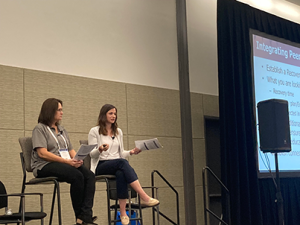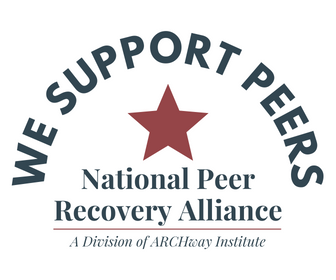Peer Support as an Employee Benefit
By Emily Stuckey
 ARCHway had the opportunity to present at the International Foundation of Employee Benefit Plans’ 69 th Annual Employee Benefits Conference in Boston, MA last week on improving mental health and substance use efforts through a peer support model. I had the opportunity to co present with Diana Marburger, Welfare Director of the Greater St. Louis Construction Laborers’ Welfare Fund.
ARCHway had the opportunity to present at the International Foundation of Employee Benefit Plans’ 69 th Annual Employee Benefits Conference in Boston, MA last week on improving mental health and substance use efforts through a peer support model. I had the opportunity to co present with Diana Marburger, Welfare Director of the Greater St. Louis Construction Laborers’ Welfare Fund.
In St. Louis, this Welfare Fund has developed and implemented LEAN STL – a peer support model. The Welfare Fund has hired two full-time peer support specialists to assist their members and families struggling with mental health and substance use disorders. They provide confidential support and are available 24/7 to help those they are serving navigate the resources they need to recover and get well. This is incredibly innovative work, and ARCHway is grateful to be a part of it.
At the conference, Diana was able to speak on how the Welfare Fund has integrated these two peers into their Member Assistance Program (MAP) while I spoke more broadly on the value of peer support.
History of Peer Support
Peer Support has been around for a long time. It’s history dates back to the early 18th and 19th centuries. William White’s Slaying the Dragon notes 275+ years of peer-based recovery support services starting with mutual support within Native American tribes to Temperance Societies and Inebriate Farm Colonies. I’ll let you do your research on these!
The workforce has both gained and lost traction often throughout that history. In the 1960s and early 1970s, we saw an upswing in the workforce most likely as a result of America’s declaration of the war on alcoholism and drug addiction at that time. With this declaration came a need for a larger behavioral health workforce, and who better to pull from than individuals who had recovered themselves.
Peer support was not just utilized within treatment and recovery programs, it was also utilized within Employee Assistance Programs (EAPs) in the 1970s. EAPs were first developed to support employees struggling with mental health and substance use, and if the goal of an EAP is to ensure that employees get the help they need so they can return to work, then why not incorporate peer support in these programs?
The Value of Peer Support
 Peer support is considered a best practice by SAMHSA, it is a reimbursable service through Medicaid in most states, and there are numerous trainings and development opportunities for peers nation-wide. The value of peer support lies in the peers lived experience. Peers have the ability to build immediate rapport with those they are working with, because they truly understand what they are going through. With that rapport, comes trust, and with that trust, comes engagement, and the longer we can keep someone engaged, the more likely they are to find and maintain recovery. That is our goal at ARCHway Institute – to help people truly thrive in recovery!
Peer support is considered a best practice by SAMHSA, it is a reimbursable service through Medicaid in most states, and there are numerous trainings and development opportunities for peers nation-wide. The value of peer support lies in the peers lived experience. Peers have the ability to build immediate rapport with those they are working with, because they truly understand what they are going through. With that rapport, comes trust, and with that trust, comes engagement, and the longer we can keep someone engaged, the more likely they are to find and maintain recovery. That is our goal at ARCHway Institute – to help people truly thrive in recovery!
There is data supporting peer support services. Peer support generally leads to an increase in engagement in outpatient services and a decrease in hospitalizations, emergency room visits, and criminal justice involvement. Not to mention, with these decreases comes the likelihood of cost savings. When people are not cycling in and out of the system – treatment, hospitals, and justice system – we are going to save money. They say for every $1 you invest in treatment, you save $4 in healthcare costs and $7 in criminal justice costs.
Why is ARCHway Support and Advocating for this Workforce?
Although peer support has been around for a long time, I shared that this workforce has both gained and lost traction throughout history. Right now, peer support is on an upswing, and because we know there is value in peer support, we don’t want to see a downswing in this workforce. That downswing would be to the determinant of the thousands currently struggling with behavioral health needs. So, what do we need to do differently?
William White notes several elements that contributed to the decline in emphasis on peer support. He notes over professionalizing the field, lack of a sustainable model for the peer workforce, the inability to transition individuals effectively back into the community, declining volunteers and alumni programs, and enforcing a one-size-fits-all approach to recovery.
In order to combat these elements, ARCHway is supporting the National Peer Recovery Alliance in their efforts to elevate and empower the peer workforce. Together, we believe that in order to create a sustainable workforce, we have to raise the bar for recovery. This means that we want to ensure that as peers we are helping those we are serving build their recovery capital to the point where drugs and alcohol are no longer impacting their ability to live to their fullest potential. Peers should be supporting individuals to find and maintain recovery. In addition, we are advocating for sustainability within the peer workforce – career ladders and pathways, higher pay for peers, reimbursement of peer services through commercial insurance, and we are elevating the workforce – asking for increased standards, training, and supervision. Last but not least, we are ensuring that the same emphasis is placed on recovery supports as is placed on treatment and prevention efforts because if we want people to maintain their recovery, we have to provide as much support on the back end as we do on the front end.
Support for Peers Everywhere
 All in all, our goal is simple – we want to support the peer workforce, and in doing so, we are improving a system and making that system easier to navigate. This work is helping people recover.
All in all, our goal is simple – we want to support the peer workforce, and in doing so, we are improving a system and making that system easier to navigate. This work is helping people recover.
That said, we want to thank the Greater St. Louis Construction Laborers’ Welfare Fund and Laborers’ Local 110 and Local 42 for asking us to be a part of this innovative work. Bringing peer support to their MAP program shows that they truly care about their members and their families overall health and wellness. They’ve also already seen success, so much congratulations to them on the success of this program.

